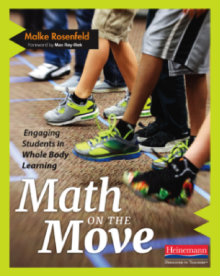Deepen Math Thinking with Percussive Dance
Math on the Move: Engaging Students in Whole Body Learning
By Malke Rosenfeld
(Heinemann, 2017 – Learn more)

As a fourth grade teacher I move around the classroom a lot! Checking on book clubs, engaging in conferences, answering the phone, walking the students to their special/cycle classes. But if you really think about it, it’s not that much movement.
Sure, it may seem like I’m always getting exercise, but when I checked my Fitbit™, I realized that it’s really just walking around and certainly is not a very active or meaningful movement process.

The first great thing about teaching artist Malke Rosenfeld’s Math on the Move is our realization that active, whole body learning doesn’t cost anything (except for the price of the book – $23.50).
When I began reading this book, I thought it would be about having students incorporate movement in the classroom to reinforce what they were learning. I was looking for strategies such as making angles with your body, using the “Cha Cha Slide” to teach slides and transformations, and so forth.
I admit I was a bit shocked to find out that I was wrong about the intent of the book. This is not a book of lesson plans or ideas on how to contort your body into strange angles and shapes to demonstrate geometric principles.
Math on the Move is much more than that.
Purposeful movement promotes learning
Malke Rosenfeld strongly believes that when students use their “whole moving body” in math studies, it must be purposeful. (To me, that’s the key word.)
For example, any teacher who teaches math uses math manipulatives. Pattern blocks can be a valuable asset to students who need kinesthetic experiences to help them visualize a math concept, term, or algorithm. Taking pattern blocks and making them into snowmen, quilts, or such may be a fun activity, but Rosenfeld tells us that “the thinking tool in math class is not the object itself but the context in which it is used; it is a context that requires learners to engage with the materials, the math ideas, and classmates to create mathematical meaning.”(p.12)
Moving around in math may productively channel some of the energy of your students, but students need to be involved in “math thinking” during whole body activity to gain the value added.
Interdisciplinary learning
Rosenfeld’s book framework is structured around interdisciplinary learning. “Both math and dance are discrete disciplines that require students to gain content knowledge, develop skills, and cultivate thinking and reasoning fluency in order to create meaning within their respective systems.” (Page xvii) It’s about making connections in mathematics through motion, body, and dance for learners. It’s about educators who want to take a risk and make “math work in novel ways.”
Rosenfeld’s experience as a percussive dance teacher, TED presenter, and author blend with her extensive research around “cognition in mathematics learning, task and activity design in a moving math classroom, and elementary math education.”
Her “Math in Your Feet” program developed as she worked with teachers who wished to add movement as a learning tool in their own classrooms. Her book is definitely on the leading edge of teaching and learning. This talk at TEDx Bloomington helps teachers gain a better sense of what’s she’s up to.
I am eternally grateful to Malke Rosenfeld for reminding me that my students need to move and for giving me strategies to incorporate movement via dance into my daily lesson plans. Rosenfeld guides the teacher toward incorporating meaningful movement activities that challenge students to apply higher level thinking strategies. I loved her activities and found myself “trying it” while I was reading the book. I found myself engaged in learning but also engaged in thinking about the math concept while I was engaging my body.
What’s in the book
Basically the book is divided into two sections. The first section is about what “Math on the Move” is and isn’t and how it relates to the teaching of math. The first chapter makes you think, wonder, and connect mathematical practices and dance movement.
The second part of the book describes the Math in Your Feet dance-and-mathematics program. Children are given a two-foot by two-foot square to dance in and a number of possible ways to move (see the classroom clips in her TEDx talk). They create steps within this framework and work with partners to make dance steps the same and different, to combine patterns of steps into longer patterns, and to transform dance movements through rotation and reflection.
There’s detailed information about how the program moves forward, and the ways to facilitate work and play and thinking and discussion, as well as lots of linked videos to really see the action.
Contents
Chapter 1 The Body as “an Object to Think With”
Chapter 2 How Is This Math?
Chapter 3 Beyond Mnemonics: Getting Started with Moving-Scale Math
Chapter 4 Math in Your Feet, Part 1: Understand, Experiment, and Create
Chapter 5 Math in Your Feet, Part 2: Combine, Transform, and Communicate
Chapter 6 Facilitating the Math-and-Dance Classroom
Chapter 7 Adapting Math in Your Feet to the Primary Grades
Chapter 8 Assess, Extend, and Connect
This book would appeal to K-8 teachers who are interested in bringing movement, dance, and math together to make their mathematics instruction interactive and meaningful. It’s about changing your mindset and your students’ mindsets about mathematics. It is jam-packed with classroom tested activities, coaching tips, video clips and research! You will literally have your students “dancing in the aisles”!
Linda Biondi is a fourth grade teacher at Sharon Elementary School in Robbinsville, NJ and a long-time Morning Meeting practitioner. She’s also the recipient of several educational grants, a Teacher Consultant with the National Writing Project, and a participant on the NJ Department of Education Teacher Advisory Panel and with ECET2 Celebrate Teaching.


































